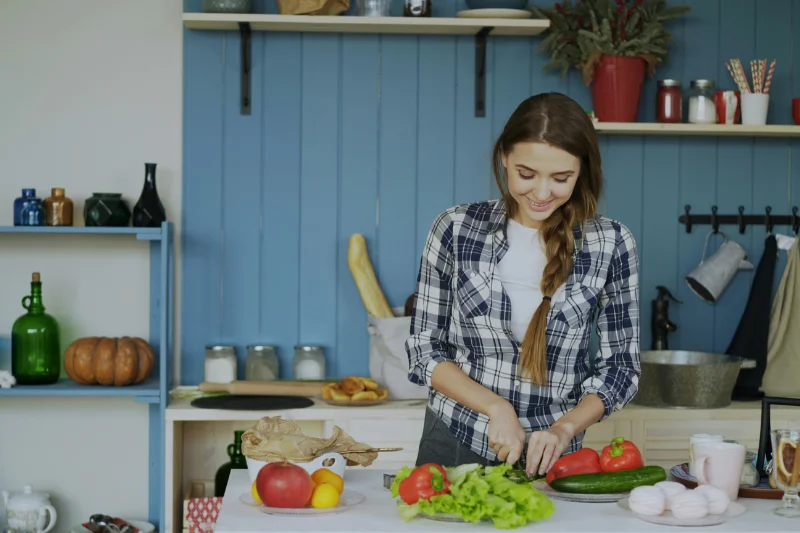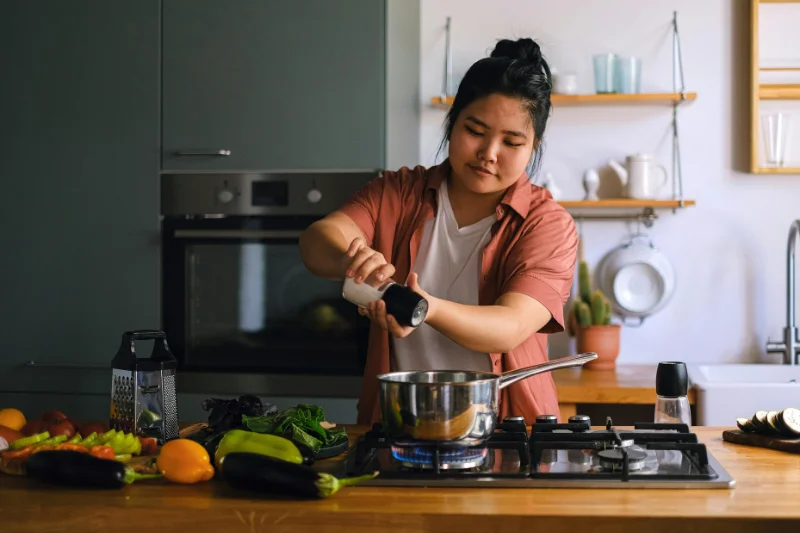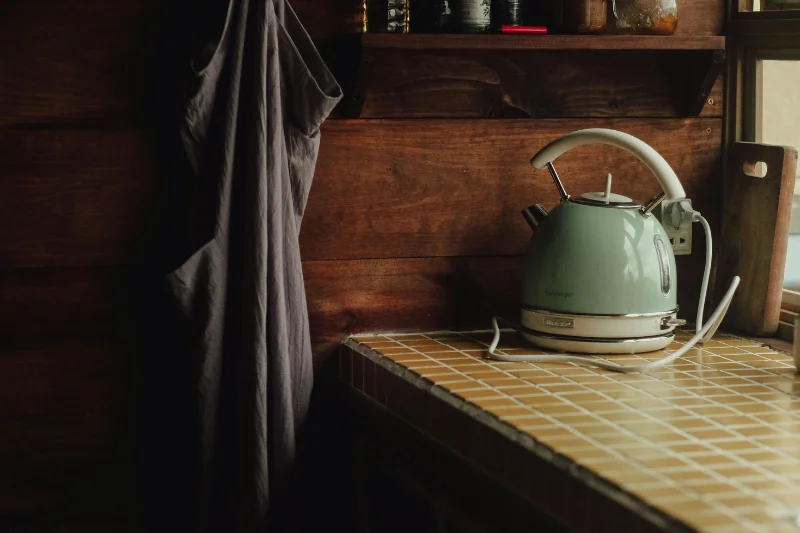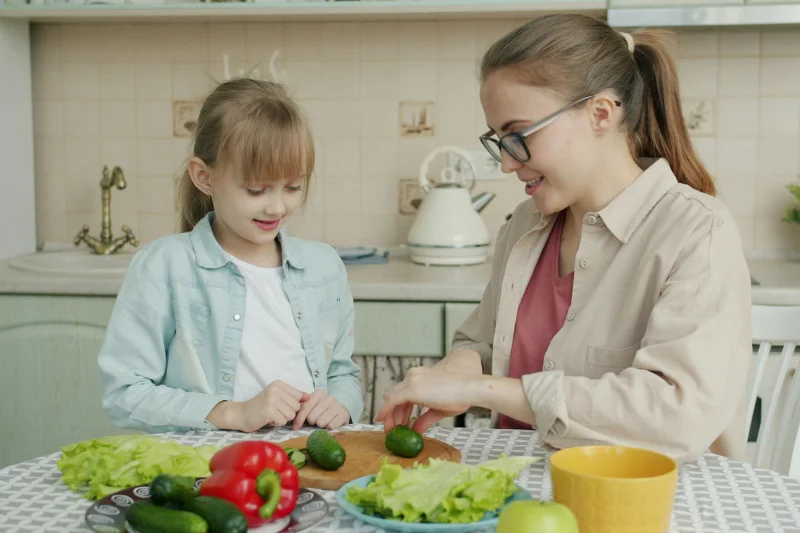
Estimated reading time: 11 minutesI am asked a lot about tips for practical household activities, and cooking is one that comes up often!
Living with Ehlers-Danlos syndrome or a related hypermobility condition can make something as ordinary as cooking and related activities challenging.
Chopping, peeling, standing for long periods, lifting saucepans and kettles may seem easy tasks, but if you have hypermobile fingers, wrists, elbows, and shoulders, it can actually be quite painful on the tissues. Not to mention managing fatigue and dysautonomia.
For this blog, I asked the advice of OT & EDS specialist, Jo Southall. Jo shares her valuable insights and creativity with us on how to manage in the kitchen.
This is going to be such a great resource with Halloween, Thanksgiving, and the festive season approaching fast.
Common kitchen challenges with EDS and HSD
Challenges in the kitchen vary a lot for everyone, but generally, I find that challenges fall into 3 key areas.
- Fatigue
- Joint problems
- Autonomic wonkiness (or dysautonomia).
The impact of fatigue when cooking is something we have to deal with regularly
Fatigue can really limit how much time we spend up and about; it can also contribute significantly to brain fog.
There is always a ‘cost’ associated with doing things, but with tasks that need doing regularly (like daily cooking), the cost ends up being cumulative.
Essentially, you’ve not recovered from yesterday’s cooking before you have to start all over again!
Often, managing fatigue is about compromises and pacing.
Compromising can include:
- simplifying recipes
- using pre-prepared meals or pre-chopped ingredients
- cooking in bigger batches so we do it less often
- delegating to others
- factoring in a weekly takeaway so you get a night off.

Pacing can be a little more complicated. I often hear ‘I don’t have time to pace’. But generally, if you’re pacing right, you actually get more done.
It’s not all about doing less. More frequent short breaks are more effective than big crash periods.
Pacing also needs to go along with assistive aids:
- Sitting down
- Using food processors rather than chopping by hand
- Choosing slower cooking methods can help hugely with pacing. I’m a huge fan of slow cookers. You can sit/lie down for long breaks between stages, and it doesn’t really impact the final result.
When your joints are the issue with cooking
The second issue, wonky joints, can impact us in a few ways.
Standing can be painful, reduced grip strength makes a lot of tasks hard, and lots of heavy bits are involved in cooking, too.
Splinting often gets a bad name amongst healthcare professionals, but I actually think it can be fantastic.
I generally recommend activity splinting. Rather than bracing every wobbly joint at all times, we instead selectively splint the ones that are put at risk by the current activity.
Examples of joint support with cooking might include:
- Wearing ring splints while chopping
- Wrist braces while lifting saucepans
- Compression leggings and an SI belt if you have to stand for long periods.

Dysautonomia and the kitchen
The third problem, autonomic dysfunction, primarily shows up in two areas. Heat intolerance and orthostatic intolerance.
Standing, especially standing still, is not great for folks with naff autonomic systems. Standing still is generally worse than walking around.
- Standing still often contributes to blood pooling, so wearing compression stockings can help.
- Learn to regularly shift your weight, tense and relax muscles
- Taking frequent sitting breaks also helps.
Heat intolerance is a little harder, especially if you’re cooking across multiple heat sources.
Some tips for this include:
- Get some windows open (unless it’s hotter outside than it is in the kitchen).
- Magnetic mesh window screens are great for keeping out bugs but letting in breezes.
- Stay hydrated (fluids and salts, especially if you’re sweating).
- Cooling scarves or even just a damp cool cloth draped around your pulse points can really help.
- If you’re particularly heat intolerant, then a phase-change cooling vest is a sensible long-term investment.
- These stay cool for hours at a time and, when worn close to the chest, help keep your core temperature down.
Tips for reducing joint pain while cooking
As I mentioned above, the joints are often one of the main problems. Advice here varies depending on which joints and why they hurt, but my best advice always starts with pacing.
Taking breaks proactively before we need them can be really useful in preventing pain exacerbation. Certainly, more effective than taking breaks after the pain has already started to get worse.
The next bit of advice is investigation. To understand why an activity is causing us pain, we need to look at what our bodies are doing during the activity.
- What is that posture like?
- How long have we been repeating the same movement?
- Does this activity place strain on a recent injury?
I tend to break pain into two key categories. The first is useless information, as in that background drone of chronic pain that many of us live with, which doesn’t really respond to anything in our daily lives.
The second is useful information. This is pain information that tells us something. Are we not strong enough for this task? Have we been doing it for too long? Are we aggravating an injury or placing strain on a weakened area?
How we respond to pain depends on what kind of pain we’re dealing with. A useful trick can sometimes be to video ourselves undertaking daily activities.
For those with particularly poor proprioception, it can be difficult to work out why an activity is causing a problem. But watching a video back can make things much clearer.
Some of the more common reasons for struggling with activities in regard to pain include:
Actions that are repetitive
In which case, alternating between left and right hand, varying between sitting and standing to change the angles that we’re working with can be helpful.
Actions that are too intensive for our current level of fitness.
Many of us carry long-term or even permanent injuries that limit our ability to function. In these cases, finding adaptive tools or pieces of equipment that do a job for us can be exceedingly helpful.
There is a huge range of online adaptive cutlery and ergonomic cooking tools. I’m a particular fan of upright ergonomic knives that place the hand above the knife and rocking motion rather than the traditional chopping motion.
Another reason we might struggle is not related to cooking itself but to what we’re doing with the rest of our day.
Sometimes, there just is not enough energy to go around, and a busy day or flare-up may mean there simply isn’t enough capacity left for cooking.
Sometimes a takeaway is a medical necessity, and ready meals can be a game-changer.
If at all possible, on good days, try batch cooking more than you need. This helps to build up a store of pre-made frozen meals which can be used on bad days.
How to modify your kitchen for accessibility
Everyone’s individual accessibility needs are different. However, there are a few accessibility tips that work for almost everyone.
The first thing is to consider which tools and activities go together naturally.
As an example, do you currently store your mugs next to your kettle? And how close are both of those to the milk in the fridge?
Ensuring efficiency within your kitchen can help to minimise how many steps you need to take, and how much bending and reaching you have to do.
Grouping things sensibly makes it easier for you to undertake a task with minimal movement, which all helps to save energy.
Another consideration is around frequency of use.
We all have things in our kitchen that we use once or twice a year for special occasions, and things that we use multiple times per day.
When looking at your storage options within your kitchen, there will always be some cabinets and drawers that are easier for us to get to.
Prioritise regularly used items in these areas. You may even be able to put infrequently used items into long-term storage outside of your kitchen. You can just get them out again for the one-off event you need them for.
Simply put, if you need it regularly, keep it approximately waist height in an easy-to-access area.

Safety in the kitchen
When designing your kitchen workspaces, make sure you have somewhere you can work safely that is not next to hot or sharp things.
For days when you’re feeling particularly clumsy or wobbly, reaching over a hot stove can be extra dangerous. Ensuring you’ve got clear space to move around in where all of the high-risk things in your kitchen are out of your immediate turning circle can make things a lot safer.
The same consideration should be put into things like trip hazards. If you have a hard tile floor, standing on a rug can really help with foot and ankle pain; however, it also creates a trip hazard.
Make sure your rug extends beyond the area where you’re likely to trip to ensure that tripping does not land you on something hot or sharp.
If you’re particularly heat intolerant, find a cooler space in your kitchen with good air flow and place a chair there; it gives you somewhere you can sit down quickly that will help you cool off if you need to.
I would also strongly recommend having a first aid kit stored in your kitchen, little accidents often happen, and there’s nothing worse than struggling to fix an injury and not having the supplies you need.
If there are activities that frequently leave you injured, for example, using sharp kitchen tools, consider safety measures that might be available.
Cut-proof gloves are a thing that exists; they’re brilliant for avoiding injuries to your fingers and hands on days when you don’t quite trust yourself around sharp stuff but still need to use the tools regardless.
I always wear mine when using a cheese grater or mandolin.
Energy-saving tips for cooking with ME/CFS or POTS
I’ve already mentioned pacing a few times, but it’s a topic I often find myself talking about, so that’s not a surprise.
As I’ve already mentioned, using a slow cooker can be a really useful way to pace out how you do meal prep.
Most recipes can be adapted for slow cooking. Key considerations are to sort the ingredients that you prepare into longest to shortest cooking time.
If you’re using meat, that goes in first. Which other ingredients are you including, and how long does each of them take to cook? You can spread your activities throughout the day, try adding one ingredient at a time, and then taking a break or doing something else for a while.
Buying pre-chopped or part-cooked ingredients can really help save energy.
Unfortunately, these options often come with a higher price tag. If you live with variable energy levels or have somebody who can help on an intermittent basis, you can try pre-preparing your own veg on good days and then freezing or canning for use later.
Micro breaks are one of my favourite pacing strategies.
Simply put, this means taking 10 to 30-second breaks regularly throughout your day.
During these breaks, we can stop and assess how we’re actually feeling. It can be a really useful way to spot symptoms early, which makes almost all interventions in terms of symptom management more effective.
This is particularly important for neurodivergent individuals with particularly poor body awareness and interoception.
Missing signals from our bodies means that we often exacerbate our own symptoms by accident or accumulate extra symptoms that are actually avoidable. Taking 30 seconds to regularly check in with our bodies and address any issues we find really helps to stop this accumulation.
From a POTS perspective, standing in the hot kitchen is really problematic.
Managing your body temperature and making sure to sit down regularly if your heart rate starts to creep up is really important. You may find smart monitoring using heart rate monitor watches helpful in the early stages of learning your limits.
Typically, I will intensively monitor my heart rate with HR alerts for two weeks every few months. It helps me to understand how my body is adapting to seasonal changes and what my current limits are.
The rest of the time, I keep a vague eye on things but don’t pay too much attention to it. I will also do intensive short-term monitoring if I’m actively unwell.
I find that something as simple as having a cold can really flare up my POTS symptoms, so keeping a closer eye on things can help me just stay safe.
Kitchen Tools for Hypermobile Hands
Which adaptations we benefit from is a very individual thing. The correct combination of tools is different for everyone.
Personally, I prefer not to use adaptive tools but rather to wear ring splints, braces, or compression gloves as needed.
There are some tools that I recommend that may be useful for you.
Quality Knives
I have a small but very high-quality and very sharp set of kitchen knives. The sharper the knife, the less effort I need to put in when chopping.
Upright agronomic knives are a great option for many people, if even the best regular knives continue to cause problems.
Jar opener grips
One area where the majority of hypermobile people struggle is opening bottles and jars.
Tenura or Dycem nonslip jar openers and coasters are a good combination option. Using the small squishy bottle openers with a non-slip coaster means that I’m able to open most bottles and jars completely one-handed.
Super useful if you have the sort of uncooperative shoulders that periodically fall out of joint and require short term immobilisation.
A Perching Stool
One piece of equipment I do really like is the perching stool. These raised chairs allow you to offload some of your body weight while still keeping your feet firmly planted on the floor.
The high seat allows you to still reach worktops. One problem with this is that it tends to jam your knees against the cupboard door. Opening the cupboard door and putting your feet inside the cupboard is a great way to get around this issue.
Another option is wheeled saddle stools. The taller versions of these serve the same purpose as a perching stool but do allow you to scoot around the kitchen when you’re operating across multiple work surfaces.
Just make sure you’re confident with your balance, and practise this before you actually do it whilst holding a knife.

Meal Planning and Prep Ideas for Flare Days
One of the really annoying side effects of brain fog is decision paralysis. I’ve experienced this myself, but I’ve also spoken to a lot of clients who have the same issue.
If you can’t decide what to eat, sometimes the easier option is not eating at all, but this really isn’t a long-term sustainable option. Particularly if you have brain fog on a regular basis.
The way I’ve got around this personally is to have a fatigue meal plan. One meal that I know how to make that is easy, safe for my dietary limitations, lasts a long time in a cupboard, and is always in the house.
In my case, my go-to meal is with Heinz tomato soup; other soups are available, but may not fit the low FODMAP criteria. Having a pre-prepared decision-free option ensures that I can at least eat something on days when my brain just doesn’t want to brain.
Having a well-stocked pantry, with lots of long-storage foods in it, is a really sensible way to ensure that there’s always something to eat in the house. If you’re prone to long flare-ups or find regular illnesses take you a long time to recover from, this really is essential.
As a backup option, powdered meals and shakes, like Huel, are a great way to ensure you’re getting all the nutrition you need without having to cook at all.
It’s also worth keeping in mind that not all flare-ups are our fault. Sometimes bad stuff just happens, and we have to learn to live with it. It’s not necessarily anything you are doing wrong; it just is. If this is the case, it may be that we need to modify how you’re cooking in order to work around the flare-up.
Final thoughts from Jo Southall
Very few of us wake up feeling exactly the same way each day, so when I work with clients, what I’m actually doing is coming up with a series of theoretical solutions to theoretical daily challenges.
It’s kind of like prepping, but for disability stuff rather than the apocalypse. Pieces of equipment don’t have to be used every day in order to be useful.
Even if you only need a perching stool once every six months, on that one day, it can be the difference between you eating a decent meal and not. The same goes for splints, braces, and mobility aids.
If you’re thinking about making changes to your kitchen layout, all the products you use, experiment a little bit.
There’s no harm in changing things gradually before actually deciding it was better the first way round. It can take a long time to fine-tune our individual approaches to self-management.
It can take even longer when our symptoms change quickly, as the modifications we put in place to manage them.
My final thought is that the advice we give regarding newborns is the same advice we should give to ourselves. Fed is best. Worry less about how you accomplish it, as long as you do.
Jo joined me for an episode of my Finding Your Range podcast to discuss Occupational Therapy and Hypermobility. Watch this episode below!
FAQ
How to cook when standing is painful?
Try Sitting instead. I know it’s not always that simple, but adding a perching stool or a wheeled saddle stool to a traditional kitchen can often make it possible to cook while perched or seated. If that isn’t an option, try using a slow cooker but plugging it in on top of your kitchen table so that you can sit to do food prep.
How do I keep from flaring when cooking?
Start with pacing. Look at how and when you’re taking breaks, and how are you’re using your energy while you’re cooking? Often over over-exhaustion is the start of a flare-up. So, working out how we can save energy can also help us avoid painful situations. I’d also recommend taking a video of yourself cooking. It feels really weird to watch back, but it can help you to spot postural issues that are contributing to your pain. It’s also worth keeping in mind that not all flare-ups are our fault. It’s not necessarily anything you are doing wrong; it just is. If this is the case, it may be that we need to modify how you’re cooking in order to work around the flare-up.
Can I cook sitting down?
Absolutely, a saddle store or a perching stool can be used when working at a normal counter height. You can also do a lot of your food prep kitchen table. If you’re a full-time wheelchair user or typically cooks at down a height adjustable worktop is a great option particularly if there are other members of the household to stand. These can be expensive so consider contacting social services and asking about disabled facilities grant.


2 Comments
Amber Buscemi - 8th October 2025
I would love to hear any advice Jo might have for short people in the kitchen. This is my number one problem with cooking. I’m always at the wrong height for the task I’m performing. I can chop and prep at the table, but I can’t change the height of the stove or sink. Any advice? Thanks so much!
Jeannie Di Bon - 10th October 2025
Thank you for your comment – yes this is probably an issue for many people. We will reach out to Jo and get her suggestions.